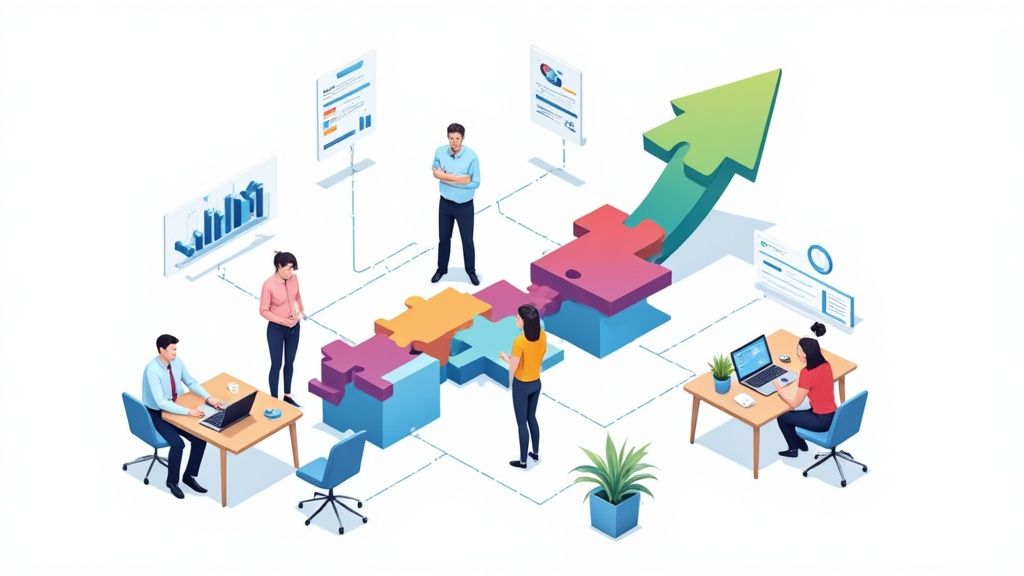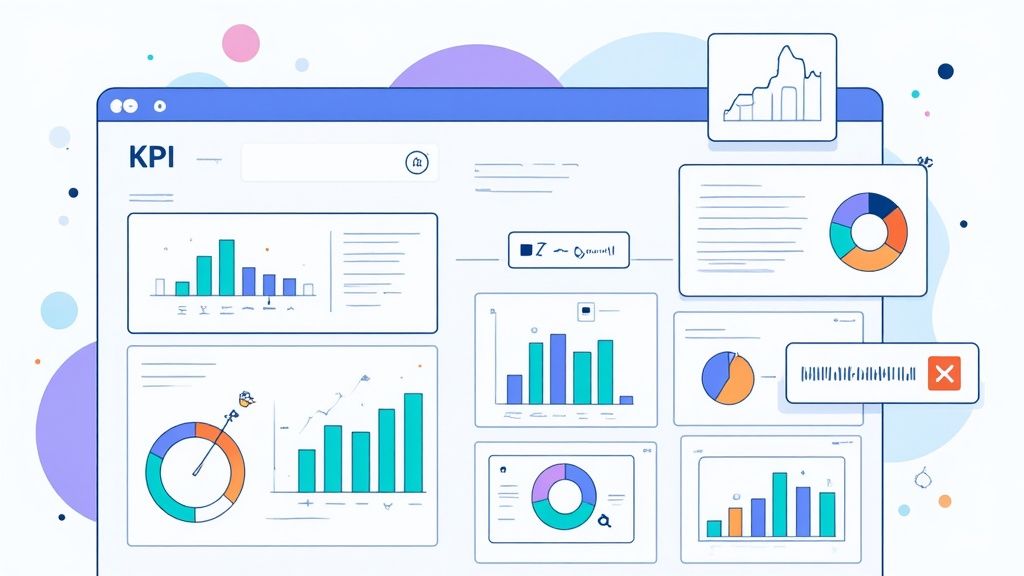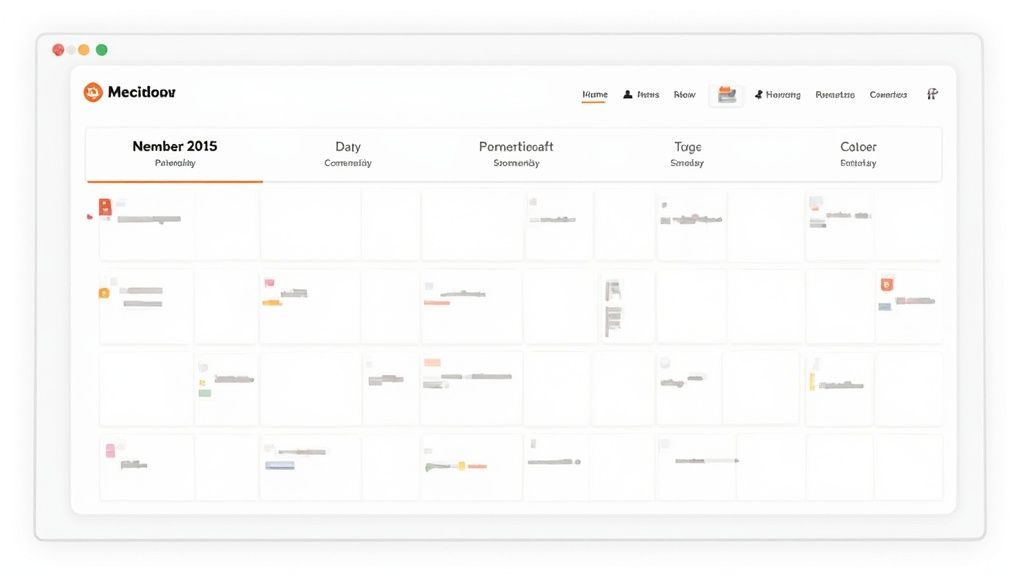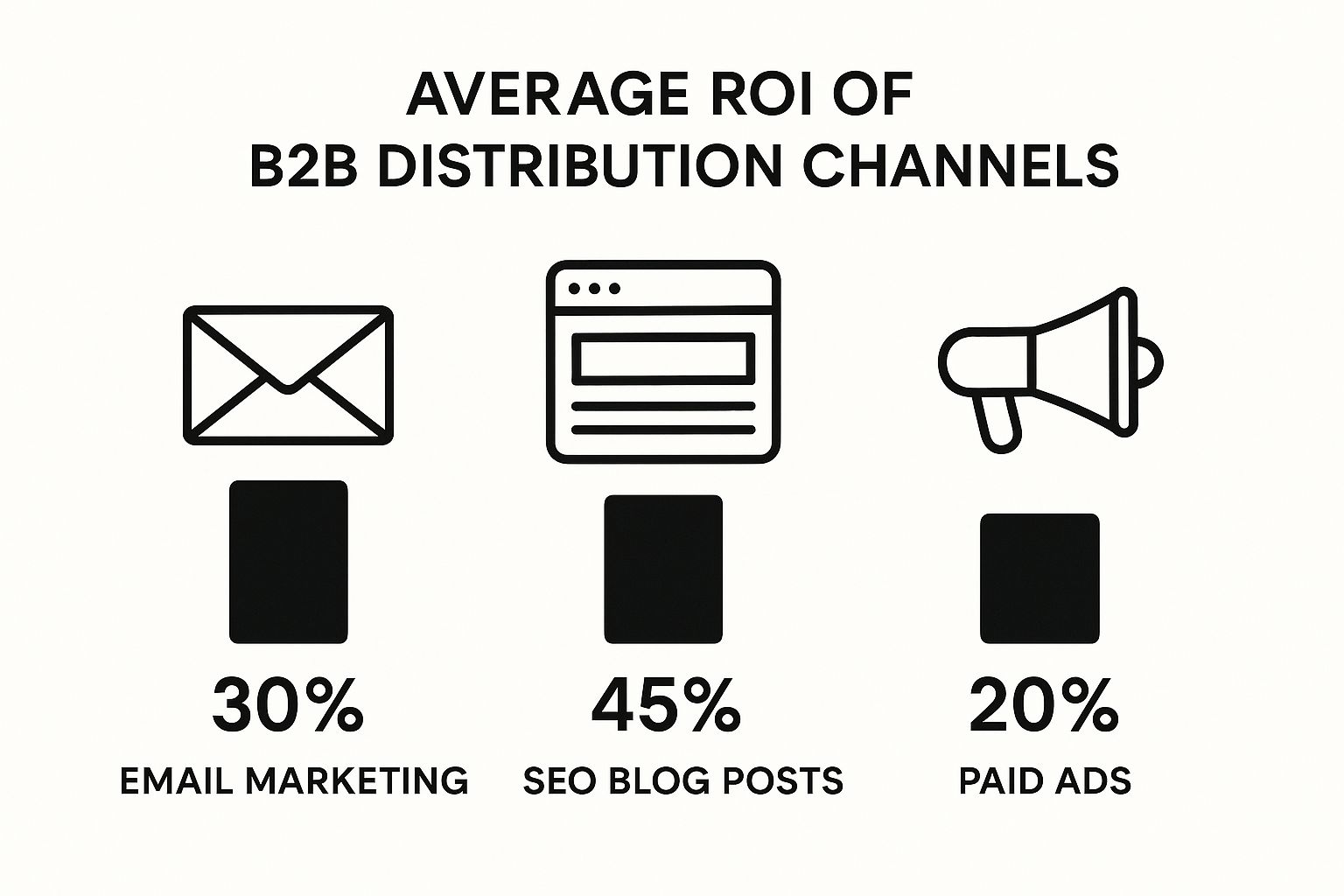B2B Content Marketing Strategy for Real Growth

Let’s be honest: a winning B2B content marketing strategy isn’t about just publishing a few blog posts and hoping for the best. It’s about building a predictable system, a machine that consistently attracts the right kind of leads. It’s a methodical approach that cements your brand as an industry authority by truly understanding your audience, focusing on strategic content pillars, and getting smart about distribution.
Building Your Foundational B2B Content Strategy
It's time to move past random acts of content and build a real engine for growth. This is what separates the high-growth B2B companies from those just struggling to get by—they build a structured program based on deep audience intelligence and content that actually delivers results.
The B2B buyer of today is more informed and self-directed than ever. They do their own research long before they ever talk to a salesperson. This is all happening as the market itself is exploding; the global B2B eCommerce market is projected to hit a staggering $36.16 trillion by 2026. This digital shift is completely reshaping how sales happen, making a strong, educational online presence absolutely essential, whether you're in advanced manufacturing or professional services.
The Core Pillars of a Winning Program
A powerful content strategy isn't just a document you create once and forget about. It's a living, breathing system of interconnected parts. Each piece builds on the last, creating a cohesive framework that guides everything from the topics you choose to how you promote them. You wouldn't build a house without a foundation, and the same goes for your content.
Here are the essential pillars that hold up any effective strategy:
- Deep Audience Intelligence: This goes way beyond basic demographics. It’s about understanding the real pain points, daily frustrations, and core motivations of your ideal customer.
- Strategic Content Pillars: Instead of trying to be everything to everyone, you define the core themes where your brand can credibly own the conversation. These pillars guide all your content creation.
- A Smart Distribution Plan: Creating great content is only half the battle. You need an active plan to promote it across owned, earned, and paid channels—wherever your audience actually spends their time.
- Clear Performance Measurement: You have to track the right metrics. This means connecting your content’s performance directly to bottom-line business goals like qualified leads and revenue.
A classic mistake is pouring 90% of your effort into creating content and only 10% into getting it in front of people. A truly successful B2B content strategy flips that ratio. Great content is useless if the right people never see it.
To help you get started with the essential planning stages, I’d recommend exploring this guide on how to develop a comprehensive SaaS content marketing strategy. Even if you're not in software, it provides a valuable framework.
To give you a clearer picture of how these components fit together, here’s a quick-reference table that breaks it down.
Core Components of a Modern B2B Content Strategy
| Component | Objective | Key Activities |
|---|---|---|
| Audience Intelligence | To deeply understand customer needs, pain points, and behaviors. | Buyer persona development, customer interviews, competitor analysis, keyword research. |
| Content Pillars | To establish topical authority and guide all content creation. | Defining 3-5 core themes, mapping topics to the buyer's journey, creating a content calendar. |
| Distribution & Promotion | To ensure content reaches the target audience effectively. | SEO, email marketing, social media promotion (organic & paid), influencer outreach. |
| Measurement & ROI | To track performance and connect content to business goals. | Defining KPIs, using analytics tools, creating performance reports, optimizing based on data. |
Focusing on these fundamentals is the key to building a content program that doesn't just attract eyeballs but drives real, meaningful business growth. Now, let's get into the actionable frameworks to make it happen.
Decoding Your Audience and Competitive Landscape

Let's start with a simple truth: a successful B2B content marketing strategy is built on knowing who you're talking to and what keeps them up at night. If you don't get this right, you're just creating noise.
Moving past generic assumptions is the first real step. You need to create content that doesn’t just get clicks but actually starts meaningful conversations. This means digging into the real-world, day-to-day challenges your audience is grappling with.
Truly great content answers the specific, often unspoken, questions your ideal customers are typing into Google. It’s not about guessing their pain points—it’s about finding cold, hard evidence. And believe it or not, the best intel is probably already sitting inside your own company, just waiting for you to find it.
Build Buyer Personas With Real-World Data
Forget those flimsy personas with just a job title and company size. A powerful B2B buyer persona feels like a real person because it’s built from real conversations, real problems, and real behaviors. It should capture their goals, their roadblocks, and the exact words they use to talk about them.
The best sources for this aren't marketing surveys. They're the people who talk to customers every single day.
Here are a few goldmines for genuine audience insight:
- Sales Call Recordings: Listen to how prospects actually describe their problems. What questions pop up over and over? These are pure gold for content ideas.
- Customer Success Interviews: Your CS team knows exactly why happy customers stick around and what problems your product solved for them. Ask about those "aha!" moments.
- Support Ticket Analysis: Look for patterns in support tickets. Recurring issues and questions are a direct signal of immediate frustrations your content can solve proactively.
The goal is to shift from, "We think our audience struggles with X," to, "We know our audience struggles with X, and they describe the problem as Y." That small change makes all the difference, helping you build trust from the first sentence.
Conduct a Competitive Content Audit That Finds Gaps
Once you have a handle on your audience, it's time to see what your competitors are telling them. A competitive content audit isn't about copying anyone. It's about finding the gaps they’ve left wide open—the topics they've glossed over, the questions they answered poorly, or the formats they completely ignore.
Your unique angle is hiding in those gaps.
Start by picking three to five direct and indirect competitors. Then, dive into their content, looking closely at a few key areas.
Key Areas for Competitive Analysis
| Area of Analysis | What to Look For | The Opportunity |
|---|---|---|
| Topic Coverage | Are their articles surface-level or do they go deep? Are they broad or niche? | Find the niche topics they ignore or the broad topics you can cover with far more expertise. |
| Content Formats | Do they only write blog posts? What about video, webinars, or interactive tools? | Introduce a format they aren't using. Think engaging carousels or a deep-dive podcast series. |
| Keyword Rankings | What keywords do they rank for? Where are they weak? | Go after valuable keywords where their content is thin, outdated, or just plain bad. |
| Tone and Angle | Is their voice dry and corporate? Is their perspective truly unique or just rehashed ideas? | Adopt a more practical, human tone or present a contrarian view backed by solid data. |
Finding Your Unique Value Proposition
This is where it all comes together. The intel you've gathered—from both your audience and your competitors—is the foundation for your entire strategy. It lets you carve out a unique space in the market.
For example, maybe your competitors all talk about high-level theory, but your audience is desperate for practical, step-by-step guides. That’s your opening.
Let’s say you sell project management software. You notice your competitors only ever talk about features and integrations. Your opening is to build content around the human side of project management—like how to manage team burnout or navigate tricky stakeholder politics.
This differentiated approach, grounded in real audience pain, is what makes a B2B content marketing strategy truly work. It’s how you stop being just another vendor and start becoming the go-to resource in your industry.
Creating Your B2B Content Production Engine

Let's be honest: great ideas are just ideas until you have a system to bring them to life. Without a solid process, even the best B2B content marketing strategy falls flat, leaving your team burned out and scrambling. It's time to shift from planning to doing.
This is where you build your content production engine—a repeatable workflow that turns those hard-won audience insights into genuinely valuable assets. The goal here isn't a mad dash for content each week. It's about creating a sustainable process that consistently attracts and nurtures leads, month in and month out.
A critical piece of this machine is the topic cluster model. This isn't just an SEO trick; it's a strategic way to organize your content that proves your expertise to both Google and your future customers.
Build Authority with Topic Clusters
So, what is the topic cluster model? It’s pretty straightforward. You create one massive, comprehensive piece of content—your pillar page—that covers a broad topic from top to bottom. This pillar then acts as a hub, linking out to several more focused cluster posts that dive deep into specific subtopics.
Think of it this way: your pillar page is the definitive guide to "B2B Lead Generation." Your cluster posts are the individual chapters, like "How to Write Cold Emails That Actually Get Opened" or "A Practical Guide to LinkedIn Prospecting."
This structure does wonders for your SEO by signaling to search engines that you have serious authority on a subject. But more importantly, it creates a fantastic user experience. You guide visitors down a logical path, keeping them on your site, engaged, and learning.
One of the biggest mistakes I see is marketers publishing a string of disconnected blog posts. By linking your cluster content to a central pillar, you build an intentional content hub that becomes the go-to resource in your niche.
Match Content Formats to the Buyer’s Journey
Different problems require different tools, right? The same goes for content. The format that works for someone just discovering their problem won't work for someone ready to buy. Your production engine needs to be versatile enough to produce the right asset for the right moment.
Here’s how I think about it:
Awareness Stage (Top of the Funnel): Your audience is just becoming aware of a pain point. Your job is to educate and attract them with low-commitment content.
- Formats: In-depth blog posts, infographics, short "how-to" videos, social media carousels.
- Example: A blog post titled, "5 Sneaky Ways Your Manual Invoicing Process Is Draining Your Budget."
Consideration Stage (Middle of the Funnel): They know they have a problem and are now actively researching solutions. You need to build trust and show them you have the answers.
- Formats: Detailed white papers, customer case studies, expert webinars, comparison guides.
- Example: A live webinar on "How to Automate Your Entire AP Department in Under 30 Days."
Decision Stage (Bottom of the Funnel): They're narrowing down their options and are ready to pick a vendor. Your content needs to seal the deal.
- Formats: Live product demos, free trial landing pages, implementation guides, ROI calculators.
- Example: A detailed case study showing how a company just like theirs saved 40% on processing costs using your software.
Getting this alignment right is what separates content that just sits there from content that drives action. Every piece you create should have a clear purpose in moving a prospect forward.
Create Content Briefs That Actually Work
Whether you have an in-house writer or you’re working with freelancers, the content brief is your single most important tool for getting quality content. It's the blueprint that turns your strategic vision into clear, actionable instructions. A good brief eliminates the guesswork and cuts down on those painful, endless revision cycles.
A rock-solid brief should always include these key elements:
- Primary Target Keyword: The main search term you're aiming for.
- Secondary Keywords: Related terms to sprinkle in naturally.
- Target Audience: A quick snapshot of the persona, their job title, and their specific pain points.
- Key Talking Points: A simple outline of the main sections and what you want to say in each.
- Internal Linking Suggestions: Which pillar page or other cluster posts should this link to?
- Competitor Examples: Links to the top-ranking articles for this topic, with a few notes on how we can do it better.
This level of detail is non-negotiable, especially since so many businesses rely on outside help. In fact, a whopping 84% of companies now outsource content creation. A tight brief is the only way to ensure those partners create content that hits the mark and sounds like you. For more on industry trends, you can get more details about B2B marketing statistics on leadforensics.com.
By systemizing your production with topic clusters, aligning formats with the buyer's journey, and insisting on detailed briefs, you’re no longer just creating content. You're building a reliable engine that produces results.
Mastering Content Distribution and Promotion

Let's get one thing straight: the most brilliant piece of content is absolutely worthless if the right people never see it. Creating great content without a solid distribution plan is like putting up a billboard in the middle of the desert. This is the moment your B2B content marketing strategy pivots from creation to activation.
The old "if you build it, they will come" mindset is long dead. These days, promotion is just as critical as production—maybe even more so. A thoughtful distribution plan makes sure your valuable assets actually reach your ideal customers on the channels they already use and trust.
This isn't about just one channel, either. It’s a mix of owned, earned, and paid media, with each playing a distinct part in building awareness, nurturing leads, and ultimately, driving conversions.
First, Your Owned Channels
Your owned channels are the platforms you control entirely: your blog, website, email list, and company social profiles. Think of these as your digital home base. They should always be the first stop for any new content you publish.
Start by making sure your blog is buttoned up for search engines. To really get traction with your B2B content, a firm grasp of understanding search engine indexing is non-negotiable. After all, this is how your content gets found in the first place.
And don't forget your email list. It’s one of the most powerful tools in your arsenal because these people have explicitly asked to hear from you. Avoid just dropping a link. Instead, frame the content within your newsletter. Explain why it's so valuable and what specific problem it solves for them.
LinkedIn Is Your B2B Main Stage
For any B2B brand, LinkedIn isn't just another social network; it's the main event. It’s where your buyers, partners, and future rockstar employees are spending their time. But just posting a link to your latest article won't cut it.
A winning LinkedIn strategy requires a bit more finesse:
- Employee Advocacy: Get your team involved, especially your subject matter experts and leadership. A share from a personal profile will almost always get more traction than a post from a company page. People trust people.
- Engaging Formats: Don't just share links. Repurpose your content into native LinkedIn formats. A blog post can become a text-only summary of key takeaways, a visual carousel, or even a short video.
- Targeted Amplification: Use LinkedIn Ads to get your best content in front of a hyper-specific audience. You can target by job title, company size, industry, or even a specific list of accounts, ensuring every dollar is spent reaching true potential customers.
Pro-Tip: Spend a small budget—even just $50-$100—to boost your top-performing organic posts. This gives them an initial kick, signals to the algorithm that it's good stuff, and helps you see what truly resonates before you go all-in with a bigger budget.
The Art of Repurposing Your Content
The secret to getting maximum reach without burning out your team? Stop thinking in one-off content pieces. Instead, start seeing every major asset as the source for dozens of smaller "micro-assets." A single, comprehensive webinar can easily fuel your content calendar for weeks.
Here’s what that looks like in the real world:
- The Pillar Asset: You host a fantastic one-hour webinar on "Scaling Your Sales Outreach."
- The Breakdown: The full webinar recording is immediately a valuable, shareable asset.
- Blog Content: The key talking points become a detailed, how-to blog post.
- Social Gold:
- Cut the most powerful 60-second clip for a native LinkedIn video.
- Design a 5-slide carousel explaining the core framework.
- Pull out a killer quote and create a shareable graphic.
- Lead Nurturing: Use the webinar's key lessons to write a 3-part email sequence for new leads.
This "create once, distribute forever" approach is a cornerstone of an efficient and effective B2B content marketing strategy. It multiplies your impact, ensuring your core message connects with different audience segments in the formats they prefer. There are tons of creative ways to get more mileage from your work, so it's always smart to explore different content promotion strategies to keep your pipeline full.
Measuring What Matters and Optimizing Your Strategy
A successful B2B content marketing strategy runs on data, not guesswork. Let's be honest—if you aren't measuring, you're just throwing content at the wall and hoping something sticks. To really understand your impact, you need to look past vanity metrics like page views and social media likes. The real story is in the numbers that signal genuine business growth.
This means you have to connect your content directly to what the C-suite actually cares about: leads, pipeline, and revenue. It's all about building a clear, data-driven narrative that proves your content isn't just a cost center, but a powerful growth engine for the entire company.
The image below shows just how different your returns can be across various channels, hammering home why tracking ROI is so critical.

As you can see, organic channels like SEO-driven blog posts often deliver the highest long-term ROI. This really highlights the value of a well-executed, patient content strategy.
Building Your B2B Marketing Dashboard
The secret to effective measurement is organizing your KPIs by their role in the buyer's journey. A random jumble of numbers is just noise. What you need is a structured report that tells a compelling story of how you're turning strangers into loyal customers.
A simple yet incredibly powerful way to do this is with a dashboard that tracks metrics across the entire marketing funnel. This gives you a clean, at-a-glance view of what’s working and what’s falling flat at each stage.
When it comes to tracking, not all metrics are created equal. You need to focus on the key performance indicators (KPIs) that truly reflect progress at each stage of the funnel.
We've broken this down into a simple table to show you what to focus on.
B2B Content Marketing Metrics by Funnel Stage
| Funnel Stage | Primary Goal | Key Metrics to Track |
|---|---|---|
| Top-of-Funnel | Attract and engage a relevant audience. | Organic Traffic, Keyword Rankings, Branded Search Volume, Backlinks Acquired |
| Mid-Funnel | Convert anonymous visitors into known leads. | Marketing Qualified Leads (MQLs), Content Download Rates, Webinar Registrations, Newsletter Subscribers |
| Bottom-of-Funnel | Prove direct impact on sales and revenue. | Sales Qualified Leads (SQLs), Content-Influenced Pipeline, Customer Acquisition Cost (CAC), Attributed Revenue |
By tracking these specific KPIs, you move beyond just counting clicks and start demonstrating real, tangible business value from your content efforts.
The most crucial shift you can make is moving from measuring content activity to measuring content impact. Knowing a blog post got 10,000 views is nice. But knowing it generated 50 MQLs that led to $150,000 in pipeline? That’s what gets your budget approved for next year.
The Quarterly Review and Optimization Cycle
Data is only valuable if you actually do something with it. A static dashboard is just a report card; a dynamic strategy needs a consistent cycle of review and optimization. I've found that a quarterly review is the perfect cadence for this. It’s frequent enough to stay agile but long enough to let real trends emerge from the noise.
Your quarterly review meeting should have a clear, simple agenda. No fluff.
The Quarterly Content Review Agenda
| Agenda Item | Objective | Key Question to Answer |
|---|---|---|
| Performance vs. Goals | Assess progress against the quarter's KPIs. | Did we hit our MQL, traffic, and pipeline targets? If not, why? |
| Top-Performing Content | Identify the "winners"—what drove the most results. | What topics, formats, and channels are really resonating? |
| Underperforming Content | Find the "losers"—the content that fell flat. | Was it the topic, format, promotion, or something else? |
| Action Plan for Next Quarter | Create concrete next steps based on the data. | How do we double down on what’s working and fix or kill what isn’t? |
This process forces you to make smarter decisions. When a piece of content underperforms, it doesn't mean you have to scrap it. Often, a simple content refresh or a new promotion strategy can breathe new life into it. In fact, many high-performing teams have developed 10 proven content repurposing strategies to boost ROI by turning old assets into fresh formats.
By consistently measuring what truly matters and using that data to refine your approach, your B2B content marketing strategy transforms into a continuously improving system—one that delivers predictable, compounding returns over time.
Future-Proofing Your B2B Content Program
So, you’ve built a B2B content marketing strategy that’s humming along and delivering results. That’s a huge win. But now the game changes. You’re no longer just building—you’re scaling, innovating, and looking around the corner.
To really stay ahead, you need to think beyond simply reacting to market shifts. The goal is to evolve your content program into a forward-thinking operation that anticipates what's next. This isn't just a marketing function anymore; it's about fostering a true content culture across your entire company.
A great first move is to empower your own internal subject matter experts (SMEs). Your engineers, product managers, and customer success leads are sitting on a goldmine of authentic insights that your audience is desperate for. You just need to make it easy for them to share.
Think simple systems: a dedicated Slack channel for content ideas, or super-short interview templates they can fill out in 15 minutes. The key is to help them contribute their expertise without derailing their actual jobs.
Integrating AI and Embracing New Trends
Let’s talk about AI. It’s no longer some far-off concept; it’s a practical tool that can help you scale your efforts right now. Use it to brainstorm initial topics, whip up a quick outline, or optimize your existing content for SEO.
Think of AI as an assistant—it’s there to augment your team’s expertise, not to replace the genuine human voice your audience has come to trust. And as the tech evolves, things like AI-powered advertising can give your promotion strategies a serious boost.
The data on where to invest is also pretty clear. A mid-2024 analysis looking ahead to 2025 found that 61% of B2B marketers plan to increase their investment in video. Meanwhile, 52% are doubling down on thought leadership content. This tells us there's a major shift toward more engaging, authoritative formats that build real credibility and trust. You can dig into these investment trends and see how B2B marketers are allocating their budgets on Statista.
The future of B2B content isn't just about what you create but how you create and connect with your audience. The most resilient strategies will be those that blend technological efficiency with deep human insight and community.
This forward momentum also applies to where you share your content. Building an engaged community, whether it's on a platform like LinkedIn or in a dedicated brand forum, creates a powerful moat around your business. It’s how you turn passive readers into active advocates.
For a deeper dive into growing on a specific channel, you might find our guide on building a modern LinkedIn content strategy helpful.
By nurturing a company-wide content culture, using AI strategically, and focusing on community, you're not just running a content program—you're building a competitive advantage that will last for years.
Frequently Asked Questions
When you're digging into a new B2B content marketing plan, a few practical questions always seem to pop up. Let's tackle some of the most common hurdles I see marketers face, from getting the budget to proving it was all worth it.
How Do You Get Budget for a B2B Content Marketing Strategy?
Here's the secret: stop asking for a "content marketing budget." Instead, ask for an investment in a revenue-generating program. You have to speak the language of the C-suite, and that language is built on business impact, not marketing activities.
Your first step is to build a conservative forecast. Don't promise the moon. Use realistic industry benchmarks to project how much organic traffic you can generate and what a reasonable conversion rate to marketing-qualified leads (MQLs) looks like. Then, work with your sales team to put a dollar value on those MQLs based on past performance.
Instead of talking about blog posts, frame the conversation around revenue. For example: "A $10,000 investment in our content plan will generate an estimated 40 MQLs over six months, influencing a projected $150,000 in our sales pipeline." An argument backed by data is always more persuasive.
How Long Does It Take to See B2B Content Marketing Results?
This is where patience becomes your superpower. Content marketing isn't like flipping a switch on a paid ad campaign; it's a long-term play that builds momentum over time. You won't see a flood of new leads in the first week.
In my experience, you'll start seeing early signs of life—what I call "traction"—in about 3-6 months. This usually shows up as better keyword rankings and a noticeable, steady climb in organic traffic. But for the really good stuff, like consistent lead flow and a clear ROI, you need to give it closer to 9-12 months. That's when the magic really starts to compound.
How Do You Properly Measure Content ROI?
Forget about vanity metrics like page views and social likes. They feel good, but they don't pay the bills. True ROI measurement ties your content directly back to closed-won revenue.
The best way to do this is by tracking performance across the entire sales funnel. Your CRM should be your best friend here. Use its attribution models to see exactly which blog posts, whitepapers, or webinars a prospect engaged with before they became a lead, an opportunity, or a paying customer.
Focus on these key KPIs:
- Content-Sourced MQLs: Leads that came directly from a piece of content, like downloading an ebook.
- Content-Influenced Pipeline: The total dollar value of all sales opportunities that touched your content at any point in their journey.
- Customer Acquisition Cost (CAC): How does the cost to acquire a customer through content compare to other channels like paid search or events? This tells you how efficient your strategy is.
Ready to transform your content into visually stunning carousels that captivate your audience? With Lumeo, you can effortlessly create engaging visual assets from any text, video, or article, maximizing your reach on platforms like LinkedIn and Instagram. Start creating for free and see the difference. Discover how Lumeo can elevate your content strategy today.